The story of the Frog Capital of the World is the tale of a small town populated by French Canadian settlers over 200 years ago. For those who have never seen the appropriate Bugs Bunny cartoon or the original Muppet Movie, the French are renowned as culinary masters. They are equally renowned for their tremendous love of eating frogs’ legs.
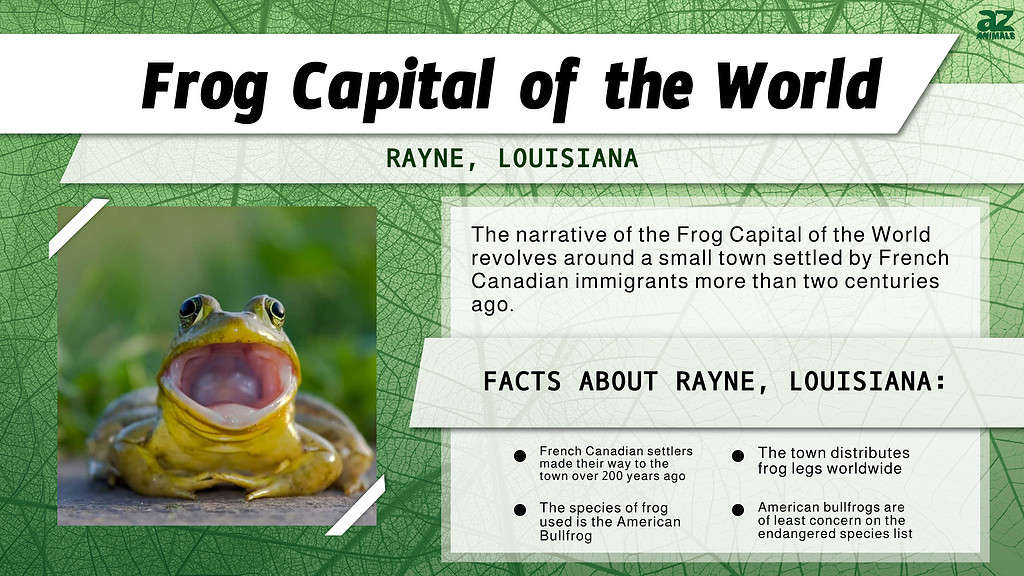
Louisiana, home to the mucky Mississippi Delta and plentiful wetlands and swamps, has a massive abundance of frog life. It was only a matter of time before an enterprising town capitalized on this perfect pairing of supply and demand. That’s how Rayne, Louisiana became the little US town known as the “Frog Capital of the World”! Let’s discover more.
History of Rayne, Louisiana
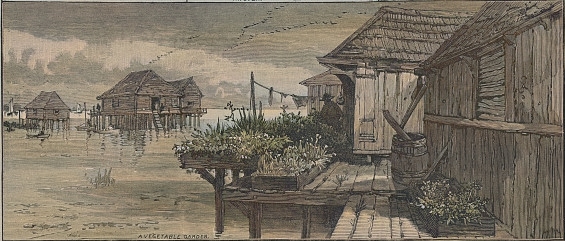
Cajuns were among multiple different peoples who settled in Louisiana.
©Drawing by Charles Graham based off sketches by J. O. Davidson / CC BY-SA 4.0 – Original / License
150 miles West of New Orleans, just a little way inland from the warm Gulf of Mexico, sits Rayne. It’s an unassuming little American town of just 8,000 souls. This town was settled two centuries ago by displaced Cajuns. Cajun history and culture are fascinating. Its origins in the French Empire of the 19th century explain why, when Cajuns found a wilderness brim-full of bellowing bullfrogs, they were able to turn it to their advantage.
The story of the Cajuns who would eventually reach Louisiana begins all the way back in 1604, in the rural Vendee area of France. Seeking greater opportunity, these destitute French farmers began migrating to prime land in the French Colonies. This land was known as Acadie, or present-day Nova Scotia.
They found prosperous land, but not always prosperous times. Acadie was the source of power and land struggles between the French and British Empires routinely over the years. After several change-overs, Great Britain took permanent (they thought) control of the area. Yet the Acadians, as they had come to be known, didn’t take kindly to English rule. They did their best to be ungovernable. They maintained independence from the Union Jack and largely refused to swear allegiance to England.
Acadians Settle Rayne, Louisiana

The British displaced the Acadians, who eventually settled in Southern Louisiana.
By 1755, the British crown had resolved that the only way to deal with the revolting Acadians was to displace them. This act would come to be known as Le Grand Dérangement. Branded as outlaws, the Acadians were exiled to various places: England, France, or their colonies in the Caribbean and North America.
From here, one segment of Acadians who had been booted to America’s East Coast traveled inland. Eventually, they chose to settle in Southern Louisiana, in the unclaimed rural region west of New Orleans. Fast forward a few decades, and you find over 3,000 Acadians relocating to these swampy, fertile Louisiana wetlands. Here, they made a sustainable life as fishers, hunters, and trappers. Some headed further West to dryer land where they could farm and raise livestock.
Acadians were by no means the first settlers in the Louisiana region. They encountered, married, fought and traded with Native Americans, African Americans, and immigrants from all corners of Asia, Europe, South and North America. This melding of cultures — across architecture, art, food, language, and music — resulted in the melting pot of Cajun culture we recognize today.
Rayne Becomes The Frog Capital of the World
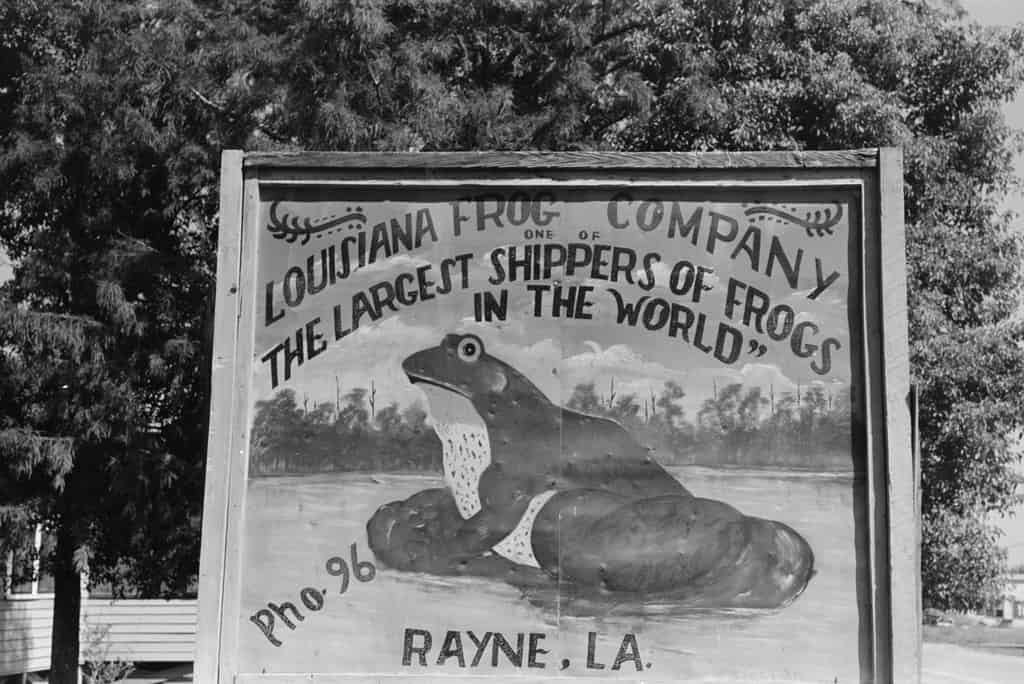
A historic sign depicting the Louisiana Frog Company that operated out of Rayne, Louisiana.
That’s how French culture made its way to Rayne. Now, let’s explore how Rayne made its own impression on France.
Rayne was a quiet little agricultural Cajun town for many decades. That was until the 1880s when they were visited by a fascinating figure, a kind of French culinary Indiana Jones: Donat Pucheu, chef-slash-explorer. A bit like Anthony Bourdain, Pucheu was obsessed with finding local food and cuisine off the beaten path. It paid off in Rayne like gangbusters.
Traveling to the sleepy hamlet, Pucheu wasn’t immediately impressed. But that was before he realized it was no easy feat to sleep in Rayne. A veritable bullfrog symphony started up each night! Investigating further, the chef learned that Rayne had an immense bullfrog population hopping and croaking about under his very feet.
The French have loved frog legs since the 1100s, predated only by the Chinese, who have eaten them since the First Century. (Monks may have started the trend in France: though they could not eat meat on Fridays, they considered frogs fish, so they could bend the rule if they were sick of halibut.)
Having a good reason to see green gold, Pucheu began trapping the muscular-legged amphibians. He would then transport them back to New Orleans. There, the finest French dining establishments paid top dollar for the coveted limbs.
The Frog Industry in Raine Explodes

The frog leg business boomed in Rayne, Louisiana by the middle 20th century.
Pucheu was extra lucky: in addition to being an ancient French delicacy, frog legs were a hot new trend in America at the end of the 19th century. But as word of Rayne spread, Pucheu found he had attracted some serious competition: French businessmen the Weills Brothers. with their greater infrastructure, the Weills were able to sell Rayne’s frogs not only in New Orleans or Louisiana, but on the East Coast, and, indeed, in France, where this whole craze first began.
Over the years, the frog business boomed. By the middle of the 20th century, Rayne had an entire frog industry, anchored by the Louisiana Frog Company Plant. The Louisiana Frog Company was the largest exporter of “gastronomic” frogs in the world, shipping 500,000 in a year. 10,000 frogs could be caught in a day and grow as large as three pounds. They sold not only food frogs but frog byproducts, including Rayne’s famous “Frog ala sauce Piquante”. There was even a branch of the plant that sold frogs for those who wished to breed them; these frogs were hand-caught to ensure their best condition.
A Frog Downturn and a Frog Festival
Tastes change, and by the 1970s the old green legs just weren’t what they used to be. Frog sales declined sharply, and the citizens of Rayne had to find new ways to move their hopping product. Seizing upon a tradition from the ’40s, Rayne established the annual Rayne Frog Festival, which has been held ever since, from 1973 to now. The event regularly draws hundreds and is like a county fair for frogs. Based on the frog derbies of the ’40s and ’50s, where folks would dress frogs up as little jockeys and race them, the Frog Festival is a three-day event that doubles as a Cajun cultural festival. Featuring French Acadian history exhibitions, French Cajun music, and, of course, frog legs ’til you croak.
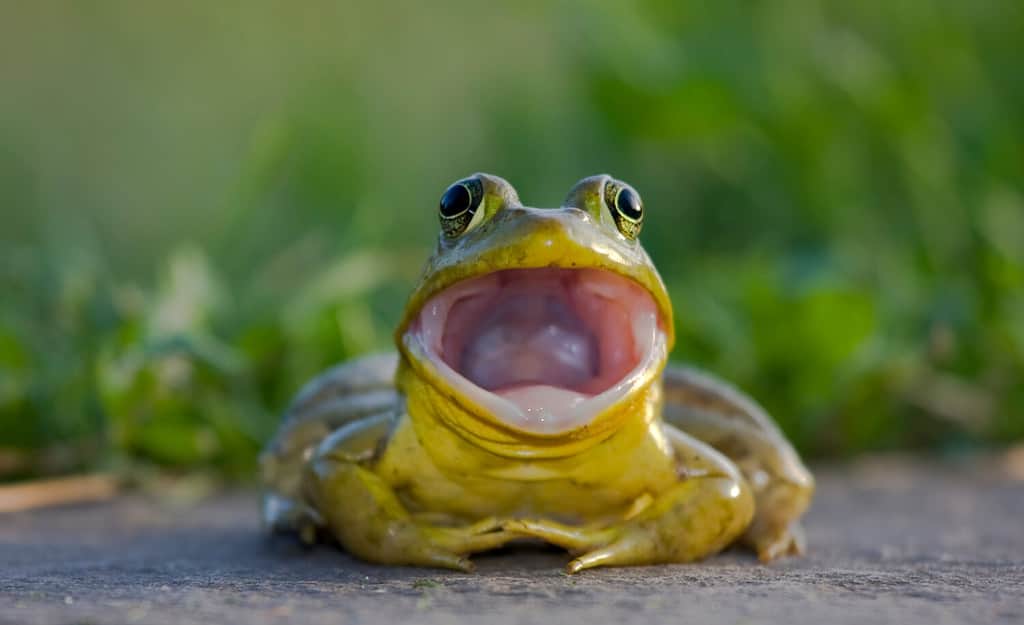
Rayne, Louisiana continues to defend its title as the Frog Capital of the World.
©Tau5/Shutterstock.com
The Frog Capital of the World Today
The plant has shuttered and Rayne is no longer supported by the faded frog leg craze. But between the Frog Festival and a wonderful selection of outdoor art, Rayne, Louisiana continues to defend its title as Frog Capital of the World. Muralist Robert Dafford was commissioned by the Rayne Beautification Board to create a series of murals around Rayne. Dafford has painted frogs, many wearing human clothes, on the businesses, trees, and buildings of the charming village. There are 35 small concrete frogs, kind of like lawn gnomes, scattered about the town. They’re about three feet high and also sport handsome human outfits. And there’s a welcoming, larger-than-life statue of a frog in a top hat as you turn off the highway to Rayne.
What Kind of Frogs Live in Rayne, Louisiana?
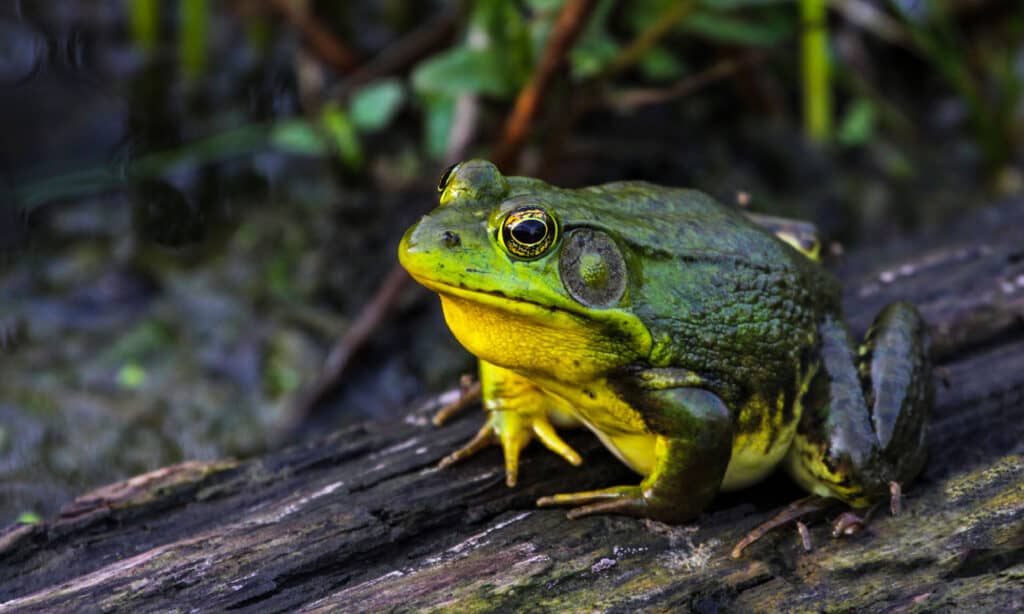
American bullfrogs are among the species inhabiting Louisiana.
©iStock.com/187715314
Rayne brought the flavor of the common American Bullfrog’s legs to many corners of the world. The American Bullfrog, or Lithobates catesbeianus, is the largest of all the species of frog found in North America. It can grow over 8 inches and weigh as much as 1.5 pounds. (That said, staff at the Louisiana Frog Company Plant swear they once had a three-pounder!) Female adult bullfrogs are slightly larger than males. The males are aggressively territorial over their little corner of the swamp.
Their color ranges from green to gray-brown with darker spots. Like humans, funny enough, they have circular tympanum, or eardrums. In fact, due to this similarity, bullfrogs were once used in NASA experiments to test the effect of outer space on their ears!
At night, they don’t turn into princes, but predators. While we may picture bullfrogs largely subsisting on bugs, they have a much wider diet: fish, snakes, rodents — they’ll even take down a bird if they get the opportunity. Bullfrogs are ambush hunters who let the prey come to them. They wait in silence for a meal to wander near them, then use their strong back legs to pounce, their big mouths wide open. Lunchtime!
American bullfrogs are of least concern on the endangered species list, as they are the most populous species of amphibian (that’s an animal that lives part-time in the water) in North America. They didn’t stay in North America, either: American bullfrogs can be found in places as far-flung as Mexico, Cuba, South America, Europe and Asia. (In some cases, the bullfrogs had human help reaching these alien shores. Definitely in the outer space case. Bullfrogs can jump high, but not out of the atmosphere!)
How Are Frog Legs Prepared in Rayne, Louisiana?
We went with a classic Cajun-style recipe for this French delicacy:
- Take 12 frog legs and submerge them in 2 cups of buttermilk and 1 tablespoon each of garlic powder and Cajun seasoning.
- Season to taste with hot sauce, garlic powder, salt and pepper.
- Mix the whole thing together and refrigerate for a couple of hours. Then place the frog legs in a colander so the excess mixture drains off. Sprinkle another tablespoon of Cajun seasoning onto the wet legs.
- Now for our dredge: mix 2 cups flour and a tablespoon each of garlic powder and Cajun seasoning. Add the frog legs and coat them in the flour mixture.
- Fry ’em! A deep fryer is ideal, but you can also use a large, high-walled skillet. In either case, use an equal mixture of olive oil and peanut oil. When the oil reaches 350 degrees, add as many frog legs as will fit. Fry them to a golden brown, then transfer them to a plate lined with paper towels to absorb excess oil.
Repeat until all your legs are fried! You’re in for a meal high in omega-3 fatty acids, vitamin A, potassium and protein (and a bit of salt and fat, just to lay it all out there!). Frog leg lovers cite a flavor not dissimilar to chicken, but with a somewhat more delicate texture — somewhere between that of chicken and fish. They describe the flavor as mild and delicate. That might be why frying frogs’ legs up pretty much like chicken drumsticks, then adding a Cajun pow! of flavor worthy of Emeril Lagasse, complements the flavor profile so well. Bon appétit!
The photo featured at the top of this post is © Christian Ouellet/Shutterstock.com
Thank you for reading! Have some feedback for us? Contact the AZ Animals editorial team.







